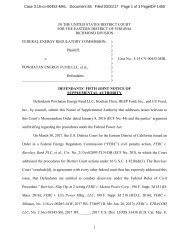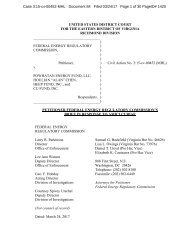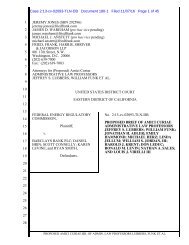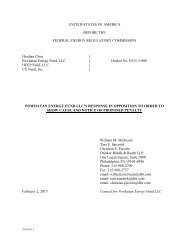Reply-ISO-Motion-for-Leave-to-File-Brief-as-Amici-Curiae
Reply-ISO-Motion-for-Leave-to-File-Brief-as-Amici-Curiae
Reply-ISO-Motion-for-Leave-to-File-Brief-as-Amici-Curiae
Create successful ePaper yourself
Turn your PDF publications into a flip-book with our unique Google optimized e-Paper software.
C<strong>as</strong>e 3:15-cv-00452-MHL Document 77 <strong>File</strong>d 12/27/16 Page 5 of 13 PageID# 1179<br />
so modified, or setting <strong>as</strong>ide in whole or in part, such <strong>as</strong>sessment.”); 42 U.S.C. § 8433(d)(3)(B)<br />
(same).<br />
FERC attempts <strong>to</strong> dismiss the proposed brief’s discussion of these two statutes <strong>as</strong><br />
involving “statutes not at issue in the current proceeding” ([ECF Dkt. No. 76] at 4), but the<br />
his<strong>to</strong>ries of these statutes and the import of the similar language used by Congress in the<br />
National Energy Conservation Policy Act of 1978, the Powerplant and Industrial Fuel Use Act of<br />
1978, and the Federal Power Act cannot be so e<strong>as</strong>ily dismissed. Indeed, the similarity of the<br />
language in these three statutes is, at the very le<strong>as</strong>t, highly probative that the language shares a<br />
common meaning. See, e.g., Northcross v. Bd. of Educ. of the Memphis City Schs., 412 U.S.<br />
427, 428 (1973) (per curiam) (“The similarity of language in § 718 [of the Emergency School<br />
Aid Act of 1972, 86 Stat. 369, 20 U.S.C. § 1617] and § 204(b) [the Civil Rights Act of 1964, 78<br />
Stat. 244, 42 U.S.C. § 2000a-3(b)] is, of course, a strong indication that the two statutes should<br />
be interpreted pari p<strong>as</strong>su.”); Welsh v. United States, 398 U.S. 333, 351 (1970) (Harlan, J.,<br />
concurring) (“In the realm of statu<strong>to</strong>ry construction it is appropriate <strong>to</strong> search <strong>for</strong> meaning in the<br />
congressional vocabulary in a lexicon most probably consulted by Congress.”).<br />
In response <strong>to</strong> this Court’s inquiry regarding the legislative his<strong>to</strong>ry of section 31(d) of the<br />
Federal Power Act, none of the parties pointed this Court <strong>to</strong> the National Energy Conservation<br />
Policy Act of 1978 or the Powerplant and Industrial Fuel Use Act of 1978. For its part, FERC<br />
pointed this Court <strong>to</strong> a number of different statutes, including the Employee Retirement Income<br />
Security Act of 1974, the Immigration and Nationality Act, the Bank Merger Act of 1966, and<br />
the Sarbanes-Oxley Act of 2002). See [ECF Dkt. No. 52] at 7-11; see also [ECF Dkt. No. 39]<br />
at 27 n.29 (discussing the Individuals with Disabilities Education Act and the Gun Control Act.).<br />
As FERC h<strong>as</strong> framed its discussion of these other statutes, “[n]umerous statutes could be<br />
5






